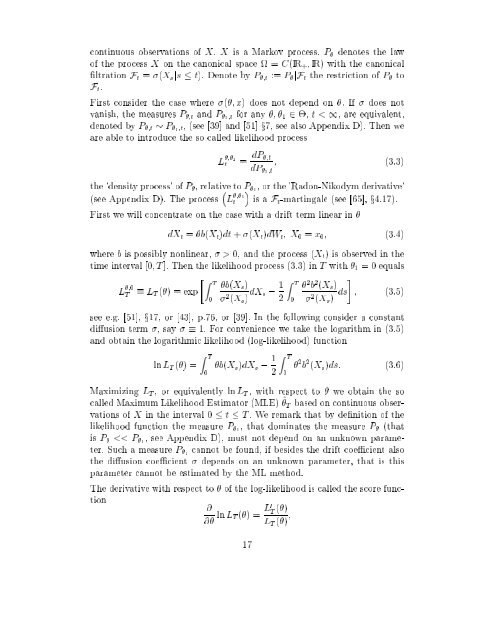Estimation in Financial Models - RiskLab
Estimation in Financial Models - RiskLab
Estimation in Financial Models - RiskLab
You also want an ePaper? Increase the reach of your titles
YUMPU automatically turns print PDFs into web optimized ePapers that Google loves.
cont<strong>in</strong>uous observations of X. X is a Markov process. P denotes the law<br />
of the process X on the canonical space = C(IR + ; IR) with the canonical<br />
ltration F t = (X s js t). Denote by P ;t := P jF t the restriction of P to<br />
F t .<br />
First consider the case where (; x) does not depend on . If does not<br />
vanish, the measures P ;t and P 1 ;t for any ; 1 2 , t0, and the process (X t ) is observed <strong>in</strong> the<br />
time <strong>in</strong>terval [0;T]. Then the likelihood process (3.3) <strong>in</strong> T with 1 = 0 equals<br />
"Z T b(X<br />
L ;0<br />
s )<br />
T L T () = exp<br />
0 2 (X s ) dX s , 1 Z T<br />
#<br />
2 b 2 (X s )<br />
2 0 2 (X s ) ds ; (3.5)<br />
see e.g. [51], x17, or [43], p.76, or [39]. In the follow<strong>in</strong>g consider a constant<br />
diusion term , say 1. For convenience we take the logarithm <strong>in</strong> (3.5)<br />
and obta<strong>in</strong> the logarithmic likelihood (log-likelihood) function<br />
ln L T () =<br />
Z T<br />
0<br />
b(X s )dX s , 1 2<br />
Z T<br />
0<br />
2 b 2 (X s )ds: (3.6)<br />
Maximiz<strong>in</strong>g L T , or equivalently ln L T , with respect to we obta<strong>in</strong> the so<br />
called Maximum Likelihood Estimator (MLE) ^ T based on cont<strong>in</strong>uous observations<br />
of X <strong>in</strong> the <strong>in</strong>terval 0 t T . We remark that by denition of the<br />
likelihood function the measure P 1 , that dom<strong>in</strong>ates the measure P (that<br />
is P
















